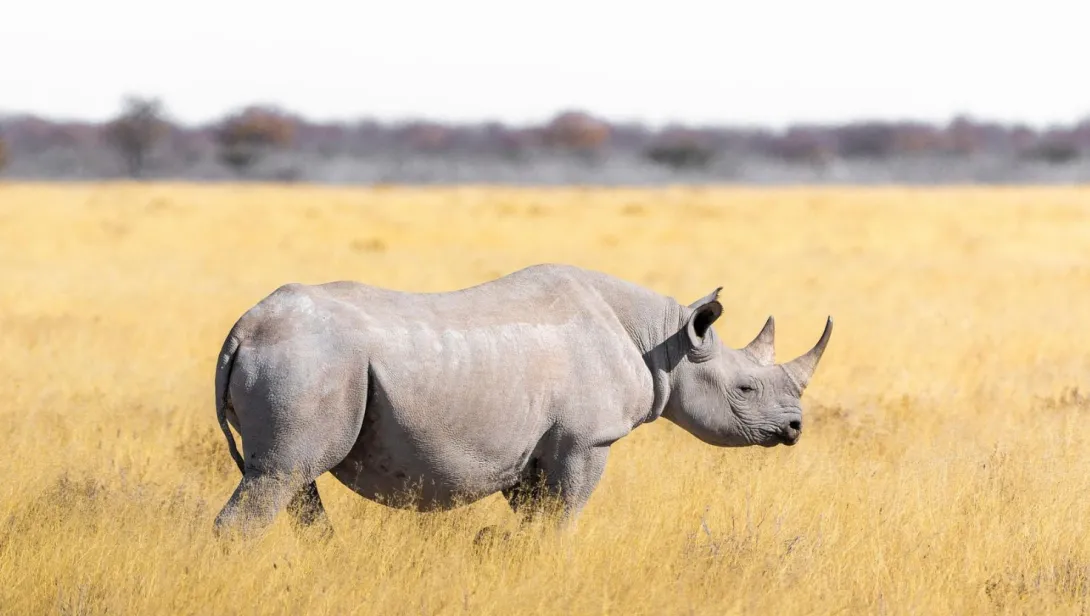Skip to main content
Introduction
- The Black Rhinoceros (Diceros bicornis) is one of the two African rhinoceros species, the other being the White Rhinoceros.
- They are known for their prehensile upper lip, which helps them grasp leaves and twigs.
- Black Rhinos are critically endangered due to poaching and habitat loss.
Physical Characteristics
- Black Rhinos have a stocky, robust body, with males weighing between 1,800 to 3,100 pounds (800 to 1,400 kg) and females slightly smaller.
- Their skin is thick and gray, with sparse hair covering their bodies.
- They have two horns made of keratin, with the front horn being longer than the rear one.
- Black Rhinos have a prehensile upper lip, which is adapted for browsing on leaves and twigs.
Habitat and Distribution
- Black Rhinos are found in sub-Saharan Africa, including countries like Kenya, Tanzania, and South Africa.
- They inhabit a variety of environments, including savannas, grasslands, and dense forests.
- Black Rhinos are solitary animals, except for mothers with calves or during mating season.
Diet and Foraging
- Black Rhinos are browsers and primarily feed on leaves, twigs, and branches from trees and shrubs.
- They use their prehensile upper lip to grasp and pull leaves and twigs.
- Black Rhinos consume up to 220 pounds (100 kg) of food daily.
- They are selective feeders, preferring certain plants over others.
Behavior and Communication
- Black Rhinos are solitary animals, except for mothers with calves or during mating season.
- They communicate through vocalizations such as grunts, snorts, and growls, as well as through scent markings.
- Black Rhinos are territorial and mark their territory with dung piles and urine.
- They are generally aggressive and will charge at perceived threats, including humans and other animals.
Reproduction and Lifespan
- Female Black Rhinos give birth to one calf after a gestation period of about 15 to 16 months.
- Calves are born weighing around 80 to 110 pounds (36 to 50 kg) and are cared for by their mothers.
- Calves stay with their mothers for 2 to 4 years before becoming independent.
- Black Rhinos have a lifespan of 35 to 50 years in the wild and up to 50 years in captivity.
Conservation Status
- Black Rhinos are classified as Critically Endangered on the IUCN Red List, with fewer than 5,500 individuals left in the wild.
- They are threatened by poaching for their horns, which are highly valued in traditional medicine and as status symbols.
- Conservation efforts include protected areas, anti-poaching measures, and community-based conservation programs.
Unique Adaptations
- Black Rhinos have a prehensile upper lip that allows them to grasp and pull leaves and twigs.
- Their thick skin protects them from thorns and insect bites while foraging.
- They have excellent hearing and sense of smell, which help them detect predators and other rhinos.
- Black Rhinos are aggressive and territorial, often charging at perceived threats.
Cultural Significance
- Black Rhinos are revered in many African cultures as symbols of strength and resilience.
- They are featured in mythology, literature, and art across Africa.
- In some cultures, Black Rhinos are considered spiritual guides and protectors.
Fun Facts
- Black Rhinos can run at speeds of up to 35 mph (56 km/h).
- They are solitary animals, except for mothers with calves or during mating season.
- Black Rhinos can go without water for several days, getting most of their moisture from the plants they eat.
- They are keystone species, playing a crucial role in maintaining ecosystem balance by shaping vegetation.
- Black Rhinos have poor eyesight but excellent hearing and sense of smell.
- They are not true dogs but are more closely related to wolves and jackals.
Threats to Black Rhinos
- Poaching for their horns is the most significant threat to Black Rhinos.
- Habitat loss due to agriculture and urbanization is a major threat to Black Rhinos.
- Human-wildlife conflict often results in Black Rhinos being killed by farmers protecting crops.
- Climate change is altering their habitats, making it harder for them to find food and water.
Conservation Efforts
- Protected areas and wildlife reserves have been established to safeguard Black Rhino habitats.
- Anti-poaching initiatives and stricter wildlife protection laws have helped reduce illegal hunting.
- Community-based conservation programs work to reduce human-wildlife conflict.
- Global awareness campaigns highlight the importance of Black Rhino conservation and encourage public support.
